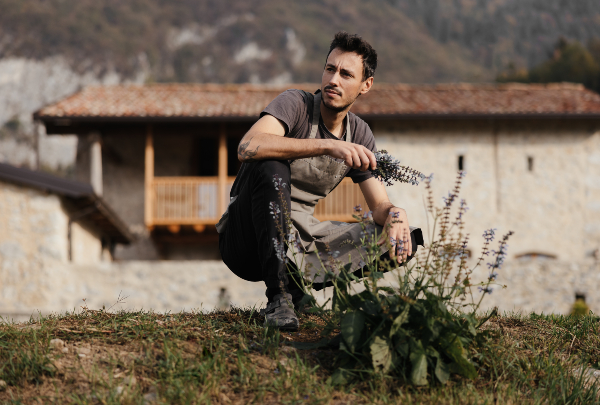Interview
Callizo, emotional cuisine
 600.jpg)
With cooking which depicts the Sobrarbe backdrop but does not forsake technique or state-of-the-art, Callizo has put its region on the gastronomic map of a Huesca that is not only now a destination for mountaineers, but also for lovers of good food.
At the convergence of the Ara and Cinca rivers, and permanently guarded by the Peña Montañesa range, is the location of the medieval town of Aínsa, capital of the old country of Sobrarbe (Huesca) and the gateway to one of the most emblematic mountain enclaves of our Pyrenees, the National Ordesa y Monte Perdido Park.
Here, in the Plaza Mayor, we find Callizo, a restaurant that not only has views of the impressive limestone rock rising up to an altitude of more than 2,000 metres to form the Peña Montañesa, but also distils mountain from the kitchen to the dining room. It is no decision taken with much reflection, but something much more natural, and “here in the mountains, that’s our option, it’s what you have close to hand, the air you breathe”, says Josetxo Couso.
Couso is half of the soul of Callizo, a gastronomic dream he shares with José Ramón Aso. They are brothers-in-law and accomplices in a type of cuisine they define as technical-emotional: “After so many years we reached the conclusion that people remember us, not because of what they expect, but because of a surprise, or an emotion we have created throughout the menu. We search for this in local produce, in the local landscape and, of course, in technique; this is our mountain technical-emotional cuisine”, explains José Ramón.
A type of cuisine that relates to a territory, not only because it brings it to plates with tastes and aromas, but because it is committed to those who genuinely care for it: producers: Couso and Aso work side by side with those who provide them with the best produce, their local produce, and most particularly they work with the “Un Paso Atrás” association – which seeks to recover typical local seeds and other cultural baggage – to show off this agricultural treasure in the Sobrarbe district. Many varieties newly recovered are used in Callizo’s kitchen – pink tomatoes, mountain apples, “pocha” or “judía” beans, such as the Fartapobres variety, “very coarse, but – according to Ramón- an amazing green” or the Vió Valley’s “boliche”, “which grows at an altitude of 1,200 metres”. Discoveries ushering in the emotional part of Callizo’s cuisine, portraying this “landscape on a plate” through “an archaeological task which provides us with knowledge and enables us to breathe new life into old gastronomic jewels which, were it not for this association, would have disappeared down through time”, explains José Ramón Aso. A task which is still ongoing – “the Sobrarbe has a thousand flavours, some of which have yet to be discovered” – although the taste of the region can now be sampled in many other products which define it, such as “different varieties of honey, fresh pollen, aromatic herbs, mountain fungus, truffles, river produce, game – we’re spoilt for choice!” says Aso.
Beyond your peaks
Although mountain areas are usually thought of as closed off, it is true that synergies are strong here too, and so these Huesca chefs only 45 km from the French border have also learned about produce on the other side of the Pyrenees. “Years ago we would gaze at the mountains up to their peaks only, but a few years ago we began to make visits to our neighbours’ territory, and we were captivated by it from the very outset”, explains Josetxo while he lists the virtues – not so far away – to be found in the French mountains, such as their “fantastic local markets, their cheese, butter, the Noir de Bigorre Pork, and wild herbs such as “ajo de oso”, which we collect at the start of spring during our weekly trips to the local markets. This is a proximity task, and simultaneously exotic in terms of the search for km 0 produce”.
And, despite geological frontiers or barriers, “life in the mountains is quite similar, however remote the location may be. Remote local produce, customs and even the problems tend to be similar”, says Couso in a reflection on interactions between territories, one of the objectives, in fact, sought by Andorra Taste, the congress on high-mountain cuisine the chefs will be attending in September. Relations between mountainous areas and rural districts which will be ever more intense, because increasingly more chefs are deciding to open a restaurant in their own village, and others who departed one day for the city and then decide to go back to their roots to continue their gastronomic passion. A decision which, according to the Callizo twosome, involves a number of factors: “the emotional part of a person heavily influences this decision – the fact that they are recovering family spaces which deteriorated due to abandonment, and also the possibility of showcasing all those local products, which are known to them and which can acquire gastronomic value, and of course the possibilities of success are much greater now with the popularity of rural tourism, and many of these destinations are available out of season in recent years”. All this, in combination with other factors such as the greater professionalism of the sector, is the reason for the appreciation in recent years of Huesca’s cuisine, of which Callizo is a good example with its Michelin star.
But there can be no doubt that the story does not end there, and there will be more success in store for mountain cookery. Mountaineers say that you climb mountains if they let you do so. It would seem that mountain cooking is coming into its own. And so, on up to the summit.



















